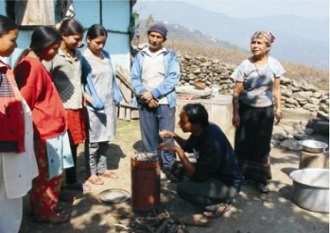The “Study on the Market Potential for Improved Cookstoves in Kinshasa, DRC” has been completed by consultants CREFES – Cabinet de Recherche De Formation et D’expertise en Sante et Developpement (International Research and Training Agency for Health and Development).
The main objective of the study was to provide essential information and data to government authorities and development partners on how to promote the use of improved stoves in Kinshasa.
A descriptive survey was conducted in 24 municipalities in Kinshasa, both in urban and rural areas. 5400 households were randomly selected and visited by 24 interviewers. Roughly 225 households were visited in each municipality. Both quantitative and qualitative approaches were used to collect data. Data was collected through: i) a review of strategic documents, records and papers, ii) general observation, iii) one-on-one interviews, iv) focus group discussions. Data was processed, tabulated, and analyzed with both Access and SPSS and the results are presented in the form of a descriptive analysis.
Besides the 5400 households that were visited, several artisans and stoves users were interviewed, and 35 people participated in three sessions of focus groups discussion. A literature review provided further information and context.
In 60% of households, charcoal was the most important source of energy used for cooking, followed by electricity (21%) and wood (9%). 61% of respondents rely on traditional/classical stoves for everyday cooking.
Improved stoves are manufactured in different areas in Kinshasa, but the production still remains very limited. Generally, 45% of improved stoves are purchased at the place where they are manufactured, and 40% are bought by housewives from a salesperson conducting door-to-door sales. Thus, only 14 % of these improved stoves were found in local markets. Housewives who regularly used improved stoves recognized its energy efficiency, and 85% of them noticed a decrease of nearly 25% in their domestic energy expenditure. In Kinshasa, domestic energy expenditure varies according to household size and revenue. In 52% of households, the monthly average expenditure on domestic energy was 15,000 Congolese francs (18USD). Of this, 95% represents the use of charcoal. Domestic energy amounts to between 10 and 15% of total household expenses.
All stoves were locally manufactured, and their prices differed according to where they are sold. Producers said that they can sell only three to four items per week. When the sale is done on site, it generated a profit that represented 20% of selling price. In other cases, sales-persons sold improved stoves direct to housewives at their home or in market places at a profit. In the latter case, the profit margin varied according to the places where they are sold.
Kinshasa has an estimated population of ten million inhabitants. The results of earlier studies show that the potential market for improved stoves is about 1 351 351 items that can be sold per year. There thus is a clear economic opportunity for such stoves if they are popularized in DRC.
As far as environmental impacts are concerned, government requires that all energy projects comply with national and international standards in relation to environmental preservation. In that regard, Congolese authorities have often subscribed to international commitments that recommend the use of renewable energy in order to protect human health and the environment. Climate change is another matter of concern for the government. Congolese authorities have always participated in international negotiations related to minimising climate change. There is recognition of the need to for managing natural resources sustainably. The promotion of improved stoves can contribute to such aims. To this end, the report recommends that the use of improved stoves in DRC needs to be prioritised politically.
For a copy of the report, contact: erika.schutze@gtz.de



